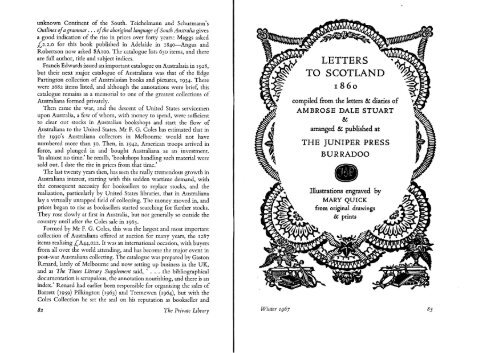Vol 8 Number 4 - The Private Libraries Association
Vol 8 Number 4 - The Private Libraries Association
Vol 8 Number 4 - The Private Libraries Association
You also want an ePaper? Increase the reach of your titles
YUMPU automatically turns print PDFs into web optimized ePapers that Google loves.
unknown Continent of the South. Teichelmann and Schurmann's<br />
Outlines of agrammar . . . ofthe aboriginal language of South Australia gives<br />
a good indication of the rise in prices over forty years: Maggs asked<br />
E2.2.0 for this book published in Adelaide in 1840-Angus and<br />
Robertson now asked $AIOO. <strong>The</strong> catalogue lists 650 items, and there<br />
are full author, title and subject indices.<br />
Francis Edwards issued an important catalogue on Australasia in 1928,<br />
but their next major catalogue of Australiana was that of the Edge<br />
Partington collection of Australasian books and pictures, 1934. <strong>The</strong>re<br />
were 2682 items listed, and although the annotations were brief, this<br />
catalogue remains as a memorial to one of the greatest collections of<br />
Australiana formed privately.<br />
<strong>The</strong>n came the war, and the descent of United States servicemen<br />
upon Australia, a few of whom, with moncy to spend, wcre sufficient<br />
to clear out stocks in Australian bookshops and start the flow of<br />
Australiana to the United States. Mr F. G. Coles has estimated that in<br />
the 1930's Australiana collectors in Melbourne would not have<br />
numbered more than 30. <strong>The</strong>n, in 1942, American troops arrived in<br />
force, and plunged in and bought Australiana as an investment.<br />
'In almost no time.' he recalls, 'bookshops handling such material were<br />
sold out. I date the rise in prices from that time.'<br />
<strong>The</strong> last twenty years then, has seen the really tremendous growth in<br />
Australiana interest, starting with this sudden wartime demand, with<br />
the consequent necessity for booksellers to replace stocks, and the<br />
realization, particularly by United States libraries, that in Australiana<br />
lay a virtually untapped field of collecting. <strong>The</strong> money moved in, and<br />
prices began to risc as booksellers started searching for further stocks.<br />
<strong>The</strong>y rose slowly at first in Australia, but not generally so outside the<br />
country until after the Coles sale in 1965.<br />
Formed by Mr F. G. Coles, this was the largest and most important<br />
collection of Australiana offered at auction for many years, the 1287<br />
items realising &4,022.<br />
It was an international occasion, with buyers<br />
from all over the world attending, and has become the major event in<br />
post-war Australiana collecting. <strong>The</strong> catalogue was prepared by Gaston<br />
Renard, lately of Melbourne and now setting up business in the UK,<br />
and as <strong>The</strong> Times Literary Supplement said, ' . . . the bibliographical<br />
documentation is scrupulous, the annotation nourishing, and there is an<br />
index.' Renard had earlier been responsible for organising the sales of<br />
Barrett (1959) Pilkington (1963) and Tremewen (1964, but with the<br />
Coles Collection he set the seal on his reputation as bookseller and<br />
82 <strong>The</strong> <strong>Private</strong> Library<br />
compiled from the letters ~c diaries of<br />
-<br />
AMBROSE DALE STUART<br />
&<br />
arranged & published at<br />
THE JUNIPER PRESS<br />
BURRADOO<br />
Winter 1967 83<br />
:



